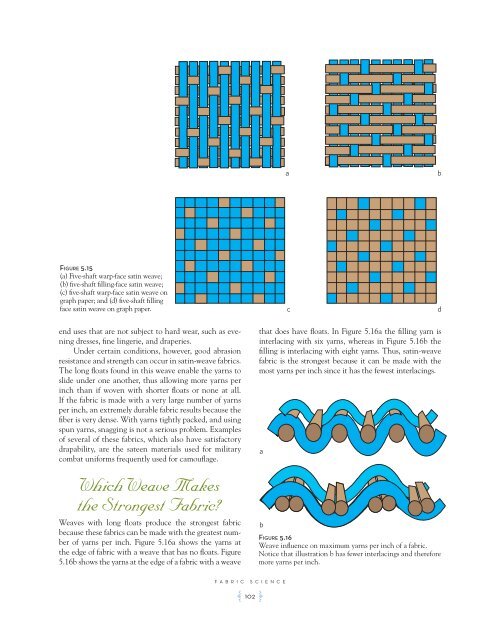Create successful ePaper yourself
Turn your PDF publications into a flip-book with our unique Google optimized e-Paper software.
Figure 5.15<br />
(a) Five-shaft warp-face satin weave;<br />
(b) five-shaft filling-face satin weave;<br />
(c) five-shaft warp-face satin weave on<br />
graph paper; and (d) five-shaft filling<br />
face satin weave on graph paper.<br />
end uses that are not subject to hard wear, such as evening<br />
dresses, fine lingerie, and draperies.<br />
Under certain conditions, however, good abrasion<br />
resistance and strength can occur in satin-weave fabrics.<br />
The long floats found in this weave enable the yarns to<br />
slide under one another, thus allowing more yarns per<br />
inch than if woven with shorter floats or none at all.<br />
If the fabric is made with a very large number of yarns<br />
per inch, an extremely durable fabric results because the<br />
fiber is very dense. With yarns tightly packed, and using<br />
spun yarns, snagging is not a serious problem. Examples<br />
of several of these fabrics, which also have satisfactory<br />
drapability, are the sateen materials used for military<br />
combat uniforms frequently used for camouflage.<br />
Which Weave Makes<br />
the Strongest Fabric?<br />
Weaves with long floats produce the strongest fabric<br />
because these fabrics can be made with the greatest number<br />
of yarns per inch. Figure 5.16a shows the yarns at<br />
the edge of fabric with a weave that has no floats. Figure<br />
5.16b shows the yarns at the edge of a fabric with a weave<br />
FABRIC SCIENCE<br />
A 102 F<br />
a b<br />
c<br />
that does have floats. In Figure 5.16a the filling yarn is<br />
interlacing with six yarns, whereas in Figure 5.16b the<br />
filling is interlacing with eight yarns. Thus, satin-weave<br />
fabric is the strongest because it can be made with the<br />
most yarns per inch since it has the fewest interlacings.<br />
a<br />
b<br />
Figure 5.16<br />
Weave influence on maximum yarns per inch of a fabric.<br />
Notice that illustration b has fewer interlacings and therefore<br />
more yarns per inch.<br />
d













